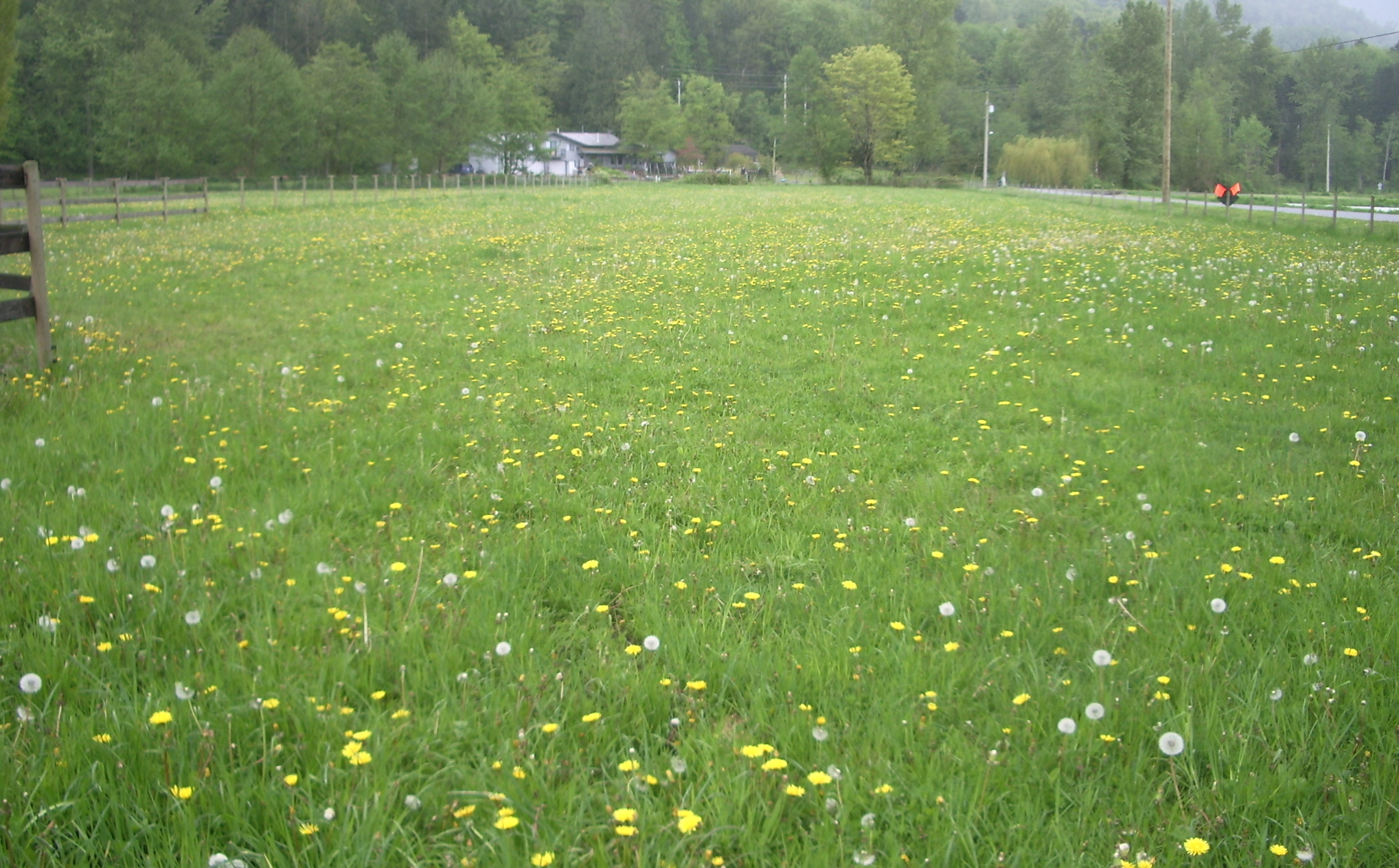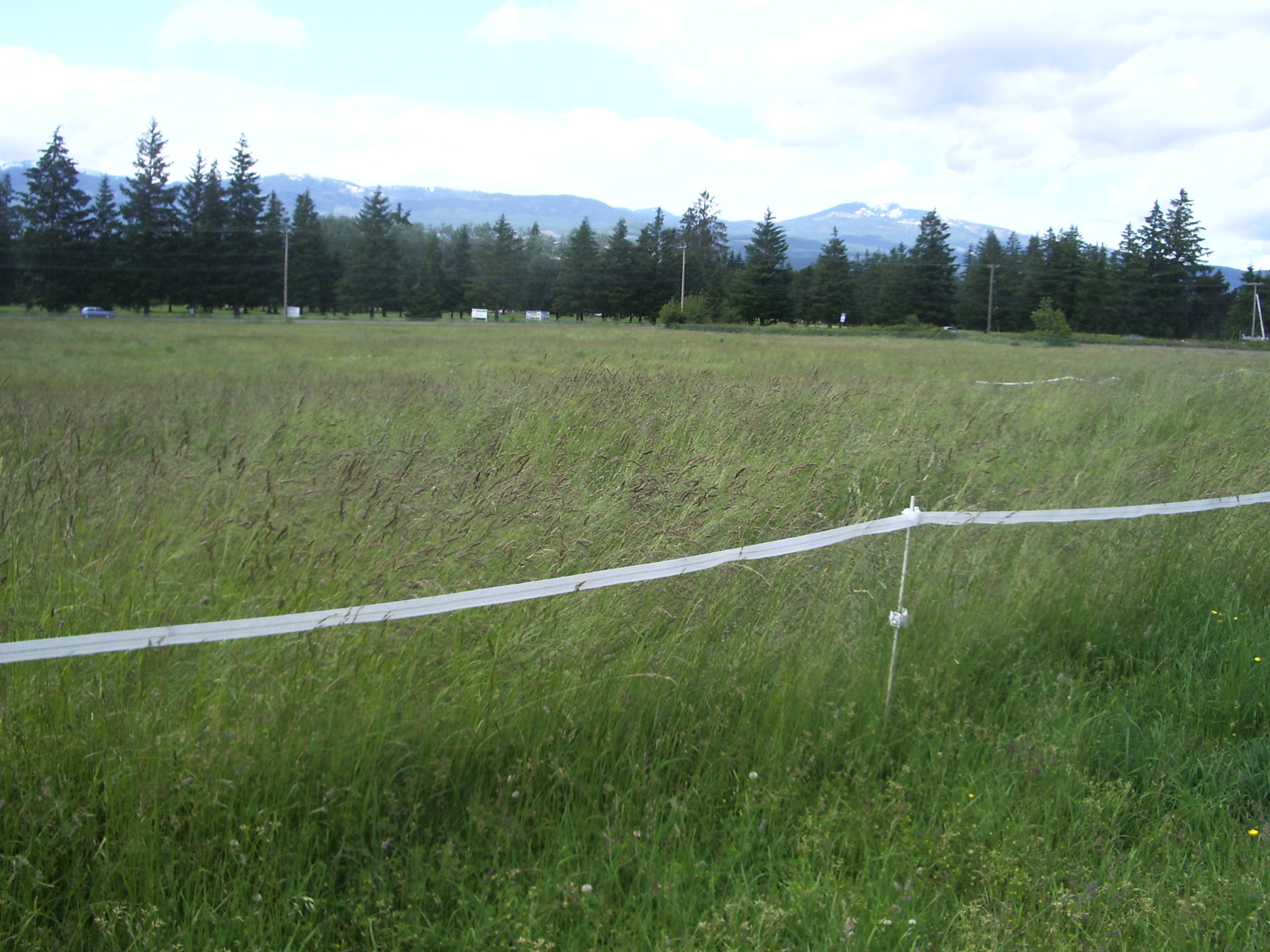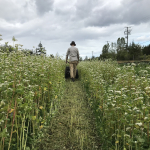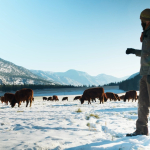Promoting Productive Pastures

Andrea Lawseth, B.Sc., M.Sc., P.Ag. AEL Agroecological Consulting
Pasture management is one of the main challenges for organic livestock producers throughout the province. In the lower mainland and on Vancouver Island, we struggle with wet climates and waterlogged grazing areas, while in the interior of the province the hot and arid climate poses other challenges that can be equally difficult to manage. Despite these difficulties, there are some techniques and tricks that you can follow to maximize the pasture that you have available and utilize your land more effectively.
Rotational and Limited Grazing
In order to maintain sales and productivity, livestock producers want to have as many animals on their land as the land can support. Sometimes we increase the numbers too much, which can result in overgrazing of pastures. Overgrazing occurs when 50% or more of the grass plant is grazed all at once. This can completely stop root growth and severely reduce grass production. Table 1 shows how grazing can affect root growth of grasses.
As the saying goes, “build your fence horse high, pig tight, and bull strong.” Fencing for rotational and limited grazing is often the best tool for reducing grazing pressure and overgrazing on your pastures. Rotational grazing involves breaking larger pastures up into smaller sections and only grazing one section at a time to allow the others to regenerate. This encourages even grazing of pastures as well as many other benefits such as: increased amount and quality of forage, increased growth of desired grass species, reduced weeds, better parasite control, better manure distribution, and more frequent animal-human contact.
As the saying goes, “build your fence horse high, pig tight, and bull strong.”
If you decide to implement rotational grazing then it is best to start by dividing a large pasture in two and grazing each of these separately. You can then divide further later on. Ideally it is best to have 4 pastures that provide enough grazing for 7 to 10 days as this gives each pasture a rest for 3 to 5 weeks. To divide pastures you can use electric fencing or tape at a height of approximately 90 cm (3 feet) or chest height of your livestock. This is a relatively inexpensive method that has proven to be highly successful. It is important to remember that you will need to monitor pasture growth at different times of the year and rotate accordingly.
Limited grazing involves turning your animals out for limited periods of time (once or twice a day, before or after work, for a few hours at a time). More supplemental feeding will be required and grass height will need to be monitored, but it provides the same benefits as rotational grazing.

Pasture Renovation
Most pastures in BC are in need of some repair due to overgrazing, wet winters, alkaline or acidic soil types, or dry summers. Grass that is lacking density with 50% weed growth or more will need to be renovated to some degree. Management strategies could include a combination of improved pasture drainage, fertilizing, harrowing, liming, and re-seeding depending on budget constraints.
The first step in dealing with an overgrazed or mismanaged pasture is to evaluate what you have to work with. Find a good weed guide to help you identify which weeds exist on your property and take some samples of your pasture soils to send them to a lab for analysis. Your lab of choice will be able to guide you on their most desired sampling technique and will be able to determine the full composition of your soil and nutrient needs.
Improving drainage through the use of surface or subsurface methods such as French drain tiles can eliminate standing water and ideal conditions for weed growth. Aerating the soil will also help water to penetrate below surface soil layers. Additionally, fertilizing with well composted manure will greatly improve soil structure and drainage. Spreading a thin layer of compost will help soil to increase its water holding capacity and will provide a great medium for spreading grass seed. It is recommended to spread once in the spring and again in the fall. Furthermore, harrowing with either a chain harrow or a tractor will also help to improve drainage and break up any clumps of manure compost you have spread.
Liming is an excellent technique for areas with very acidic soil. Weeds such as buttercup (Ranunculus spp.) or field horsetail (Equisetum arvense) are good indicators of acidic soil as they are well-adapted to these conditions. Liming should be carried out in the spring and fall and more often if needed. Again, a soil test will help to determine the pH of your soil.
Finally, re-seeding with an appropriate seed mixture for your property will help to out-compete weeds and maintain good forage production. The key to choosing a mixture is diversity. The varying grass species in a mix will grow in their respective microclimates within your pastures, which will lead to lower vulnerability to disease and pest outbreaks. However, it is still important to tailor your grass mix to the type of soil on your property and the expected use of the pasture (i.e. grazing, sacrifice area, or hay).
Make sure you mention the topography of your pastures and soil characteristics (gained from a soil analysis) to your seed retailer so that they can help identify the right mix for you. The best time to broadcast overseed your pastures is in late September to early October after you have spread your manure compost. Seeding rates will vary with grass species so check with your retailer before seeding.
Before allowing livestock onto the pasture to graze you should allow newly seeded pasture grass to reach a height of 15 to 20 cm (6 to 8 in) and remove your animals when they have grazed the grass down to 8 to 10 cm (3 to 4 in). This will ensure that the grasses have enough food reserves to permit rapid re-growth. Re-growth can take up to 2 to 6 weeks, depending on the time of year, so it is important to keep animals off wet, overgrazed pastures. Wet pastures can also lead to health problems such as foot rot and parasite infestation.
Keeping pastures mowed to a uniform height of 3 inches will help to stimulate equal growth of your grass plants. This will also help to control perennial weeds that do not respond well to mechanical control methods.
Properly managing pastures generally requires a shift in thinking from viewing the crop as a way to feed the animals to viewing the animals as a way of managing the pasture. As a grass farmer, your main goal is to ensure that the grass on your pasture is healthy enough to outcompete the weeds. Through rotational grazing and prevention of overstocking pastures, you will create the right environment to allow your grass to thrive and the soil to remain healthy and productive.
Andrea is the Principal/Owner of AEL Agroecological Consulting and a Professional Agrologist with over 11 years of experience in food system and agricultural land use planning, sustainable agricultural promtion, organic certification, and food security. AEL Agroecological Consulting provides agri-environmental consulting services to all levels of government, non-profit organizations and individuals.




